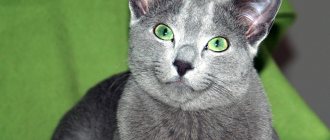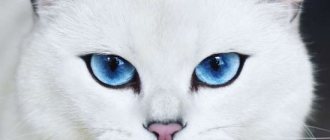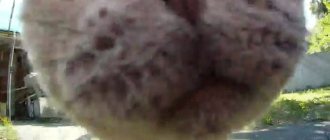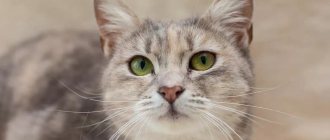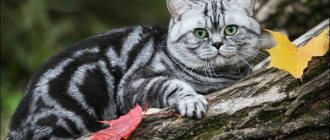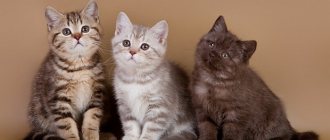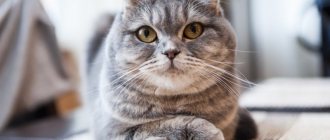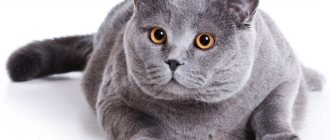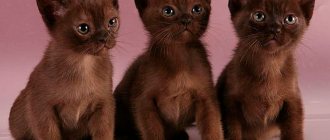Burmese cats (Burmese) are affectionate, friendly animals, distinguished by a well-built, strong body and short, glossy hair. Their good nature extends not only to the owner, but also to other pets living in the house. It is the gentle nature that leads to the growing popularity of this breed. In the article we will tell you everything about the Burmese breed, how much these chocolate cats cost, as well as how to choose the right kitten and raise it to be an exemplary representative of the breed.
Origin story
But some experts are confident that the Burmese cat originated in 1934 in America. Dr. Joseph Thompson, from a trip to Asia, brought a cat named Wong Mau to San Francisco. She had an unusual reddish-brown color and soft fur. When she was crossed with a Siamese cat, the cutest kittens were born with the distinctive breed characteristics of modern representatives of the Burmese breed.
Currently, the breed is classified by several standards:
- according to FIFe – III category – shorthair & Somali – BUR standard;
- according to WCF – III category – Shorthair – IGK standard;
- according to CFA – category SH – Shorthair – Burmese standard.
According to classifications, Burmese cats have distinctive breed features and generally accepted characteristics.
Coat color
The Burmese cat is painted in classic colors - sable, champagne, blue, platinum and cream. The upper part of the body has a more intense color; the lower to the paws, the lighter the fur. However, monochromatic colors remain in high esteem, which is becoming increasingly rare.
Sable
The Burmese cat is distinguished by its rich colors. Sable is the most common brown, almost black color. Considered the main one. She is the one shown in the photo. The ears, tail and mask on the face are highlighted in an even darker, almost black color. The pads and nose are dark brown. The eye color is golden, amber.
Champagne
The Burmese or champagne-colored Burmese is a light variation of the sable color. The main shade of the coat is milky, coffee with milk. This color option is interesting to buyers who are looking for a beautiful pet. The muzzle is highlighted with a chocolate-colored “mask”. The tail and paws are painted a darker color. The nose and pads are painted chocolate.
Blue
The Blue Burmese cat has a uniform blue coat. The nose and paw pads are painted blue with a gray tint, which is clearly visible in the photo. The lighter and cooler the shade, the better. The fur shimmers in the same way as the sable color.
Interesting!
Representatives of this color appeared randomly in 1955. The brown Burmese cat carried a recessive gene for blue color, which appeared in several kittens in the litter.
Platinum
This is a light blue color option. The Burmese cat in the photo has a platinum color. The coloring is characterized by light beige fur - the lightest of all available colors. Let's say a slight touch of purple. An even lighter, almost pearly shade is visible on the belly and the end of the paws. The pads on the paws and nose are colored brown-pink or purple.
Cream
In recent years, another color has begun to be distinguished - cream or red. This colorway is very similar to platinum, but the back is painted a deeper shade of orange. Pops of bright colors are reminiscent of the blush on baked goods. The nose and paw pads are pink. The color is in demand among a wide range of buyers and breeders.
The photo below clearly shows the difference between platinum (left) and cream color (right).
Tortoiseshell colors
The Burmese cat comes in a tortoiseshell color. Available in brown, blue, chocolate and lilac tortoiseshell. The color is distinguished by light, brown and red spots, which are evenly scattered throughout the fur. However, there is no drawing. There is no ideal standard for a given color, because... each of them is unique.
Interesting!
It is believed that tortoiseshell colors are found only among European Burmese cats
Characteristics of the Burmese breed
It is almost impossible to confuse a pet of this breed with others. After all, they have individual characteristics inherent only to representatives of the Burmese. To gain an idea of these animals, you need to read their descriptions.
Standard
Cats brought from Asia, when crossed with the Siamese breed, produced unique offspring, which were later identified as a separate breed and characterized by certain standards. There are American and European types of Burmese breed.
The reference standards, regardless of the type of breed, are as follows:
- Body: strong, well-built, muscular; size medium; have a gender difference - cats grow larger than cats; the chest is wide, rounded; the back is straight; weight is quite large for the size: 3-6 kg for females and 5-9 kg for males;
- Coat: short, smooth, thick, without undercoat (no striped pattern).
- Head: pronounced profile, with a transition from the forehead to the nose; strong chin, correct bite; the neck is well developed, wide, short; cheekbones are wide.
- Eyes: large, clearly outlined, greenish or yellow in color; the distance between the eyes is large (blue eyes and squint are considered a defect).
- Ears: regular triangular shape; slightly rounded tips; the nose is short.
- Limbs: proportional, medium in size, paws are low, have powerful muscles, paws are round in shape, have 5 toes on the forelimbs and 4 on the hind limbs; the tail is long and fluffy.
- Life expectancy: 12-17 years.
Differences between American and European Burmese
The American type has a rounded head, rounded ear tips, and huge round eyes, most often green.
The European type is distinguished by a pronounced wedge-shaped head and large, predominantly yellow eyes with straightened eyelids (eastern cut). The peculiarity of the eye shape of Europeans makes their gaze outwardly more focused and serious, in contrast to the open gaze of the American Burmese.
Photos of colors
The Burmese color standard is determined based on which direction it belongs to: American or European. It is immediately worth noting that the color of the European Burmese includes all the color options of the American standard fur.
American standard colors:
- black (sable)
- blue
- lilac (platinum)
- coffee with milk, chocolate (champagne in the USA)
Colors unique to the European Burmese:
- red (also called Burgundy)
- tortoiseshell
- cream
Health
In general, the cat’s health can be described as strong, their immunity is strong, but there are some points that are worth paying attention to:
- teeth - there is a risk of gingivitis , so regular dental examinations by a veterinarian are necessary;
- The condition of the respiratory tract of this breed needs to be given special attention - Burmese cats often suffer from lacrimation, colds, and runny nose ;
- there is a tendency to complete or partial blindness ;
- hypokalemia (low potassium levels in the blood);
- congenital deformation of the skull in kittens is possible
- tendency to diabetes.
Among other things, Burmese require regular vaccination and anthelmintic prophylaxis.
Character
Pets of this breed have a truly angelic character, they have such features as:
- calm;
- sociability;
- attachment;
- friendliness;
- not conflict.
Despite the fact that cats usually do not get along well with each other, Burmese cats are friendly towards new family members. But most of all, Burmese cats adore their owner . They depend on his opinion and mood. These pets also easily find a common language with children . There have never been any cases of aggression or revenge from these beautiful animals. And, in general, purrs of this breed are not distinguished by excessive activity and playfulness .
A rather unusual phenomenon for the cat family is that Burmese cats are easy to train . They do not create problems for their owner either in everyday life or in behavior.
The gentle temperament of Burmese cats captivates and persuades you to choose this particular breed. In addition, these animals have an innate cleanliness, which adds another advantage to them.
Historical reference
Temple inhabitants, Burmese cats, were considered deities in ancient East Asia . Such unusual animals were worshiped, and caring for the Burmese was considered a high honor by the monks and was considered one of the steps leading closer to God. Any insult inflicted on the Burmese could cause terrible punishments during life and torment after death. According to many ancient beliefs, cats of this breed were obliged to accompany their owners even after their transition to another world.
Read more - the history of the Burmese cat
The presence of a short-haired Burmese cat in the house promised the owner great happiness, financial wealth and absolute harmony in life. The most noble people sought to have such a pet, so for a long time Burmese kittens were considered a truly luxurious and very expensive gift, not affordable for mere mortals.
This is interesting! The breed came to Europe no earlier than the nineteenth century, and kittens with chocolate-colored fur quickly captivated Europeans with their aristocratic manners and simply amazing, incredibly well-developed intelligence.
In palaces, cats of this breed appeared even earlier than the famous Siamese cats, and also enjoyed truly genuine favor among the entire royal family. Information about the breed can also be found in most ancient manuscripts or books published in Thailand and Burma . Many chroniclers immortalized the animal on the pages of books, in stories about mysterious and wonderful animals. And this is partly why the origin, history, amazing qualities and legends dedicated to such an unusual pet have now become known to the whole world.
Return to content
Possible problems
There are no special breed problems or restrictions in keeping these cats, but still some points can negatively affect the health and behavior of the pet:
- Although the hair of Burmese cats is not long and is not subject to heavy shedding, it requires constant care and combing. Therefore, those who are not ready to pay attention to their pet and brush it at least once a week with a special brush should not get a Burmese cat.
- Another reason to think about purchasing a kitten is frequent trips and business trips . Representatives of the Burmese breed are strongly attached to their owner, so you should not leave your pet alone for a long time.
- A cold climate will be a serious inconvenience for a Burmese cat . Due to the structure of the skull and short nose, the cat is susceptible to frequent colds and runny noses, and frosty weather will only worsen the situation. Such conditions are unacceptable for the health of the pet.
Interesting video about the characteristics of the breed:
If there is a Burmese in the house, what do you need to know?
These cats require careful treatment. The future owner of an unusual pet needs to remember a number of rules:
- The home will become a playground for the pet.
- You cannot slam doors and windows; a curious cat may stick its muzzle or paw in at the last moment.
- Burmese are trusting, so when guests arrive, owners are obliged to keep an eye on their cat. She will suffer in silence, not showing aggression towards new people.
- The cat will ask for its share of affection, no matter what condition the owner is in.
- Children should be instructed on how to handle a cat. Explain to them that this is not a toy.
- The most difficult test for a Burmese is loneliness. If you have to leave home often and for a long time, it is better to get a second cat.
- Loyalty is a hallmark of the Burmese cat. A boring pet will no longer be able to be placed in good hands, so you should think about responsibility for it before purchasing.
Care
Burmese breeds are not particularly demanding in terms of care; it is enough to satisfy some basic needs of the animal.
Wool
The coat of a Burmese cat is special and requires attention and care. The wool is soft, comparable to mink, and has no undercoat . They are also called “silk bricks” because of their exquisite coating and considerable weight. To preserve the beauty given by nature, you need to comb the animal at least once a week with a special glove or brush. On its own, the Burmese Shorthair practically does not shed , which allows it to be kept even by allergy sufferers (only if the allergy is not to cat saliva and skin particles).
You should bathe your pet no more than once every 5 months. The only exception would be severe pollution or going to an exhibition. If the owner does not have the opportunity to care for the cat on his own, then you can contact veterinary offices that provide grooming services - caring for the appearance of pets.
Nutrition
The nutrition of Burmese cats does not differ from generally accepted standards of care, since they are not prone to allergic reactions and digestive problems. There are two options for feeding Burmese cats: homemade and store-bought food. With the right approach, both methods will be acceptable. To better understand, you need to consider each method separately.
Homemade food , of course, will have a positive effect on the pet’s well-being, but a considerable amount of time is devoted to this method. of raw defrosted meat per day , which is about 80% of the diet . The meat should be lean, preferably lamb, rabbit, beef, and poultry. To make it convenient for the cat to eat, you need to cut it into small pieces of 1x1 cm.
Vegetables and herbs are served with meat , but some Burmese cats refuse such an addition and independently look for healthy herbs in the clearing or garden. Dairy products also make up a large share of the diet: cottage cheese, yogurt, fermented baked milk . a hard-boiled egg twice a week fish meat once . The bones must be removed first.
Dry food or canned food can now be found in any veterinary store. But his choice should be approached responsibly. The main proportion of the feed composition should be animal proteins . To a lesser extent, proteins of plant origin, fiber, vitamins, and microelements are present. Good food does not require additional investment in nutritional supplements. We have prepared a rating of the best wet food, which you can see in our article.
Important! Under no circumstances should you feed your pet both store-bought food and homemade food at the same time. They are poisoned differently, so together they disrupt the digestive process.
Caring for ears, eyes and other body parts
Because Burmese cats are prone to colds and watery eyes, you need to pay attention to caring for their eyes. As with other breeds, proper weekly cleaning of the eyes and ears with a cotton swab dipped in a special solution is important. If you notice moisture near the nose and eyes, it is important to promptly wipe them with veterinary products. If the discharge does not stop, the animal must be taken to the veterinarian immediately.
These cats rarely produce claws, so there is no particular need to cut them off often. Burmese cats treat furniture with the same respect - they do not like to tear or tear it off. We can conclude that for aesthetic purposes it will be enough to cut off the claws once every 1-2 months .
Important! Cats need to have their claws trimmed correctly! In no case should this be done at the root, but only by removing the sharp ends. In addition, cutting the claw lengthwise, like a human, will cause suffering to the poor animal. You need to cut across the wide side.
Walking your pet
Since Burmese cats have a calm disposition, they are kept both in a private house and in an apartment. But in any case, free range is not the best solution. It would be ideal to accompany your pet on a walk. Because of its curiosity, the Burmese cat will try to get acquainted with all the nooks and crannies, so it would be a good idea to purchase a special leash.
Castration and sterilization
If a cat or cat is not intended for breeding, then they should be spayed or sterilized.
At what age is it recommended to sterilize an animal?
In the past, it was recommended that spay and neuter surgeries should not be performed until the female cat reached eight months of age. However, early castration is now increasingly being performed - at approximately 4 months of age. Experienced breeders, selling kittens as pets at 16 weeks of age, give the new owner an already sterilized cat or neutered cat. Sterilization is effective both at 4 and 8 months.
Caring for your pet after surgery
After the operation, the cat is put on a special blanket that will protect the seam from licking. The cat owner makes sure that the pet does not have hypothermia, and that there is clean water nearby. If your pet does not drink, then she must be given water forcibly, through a syringe without a needle. You can feed on the second day after surgery, offering the animal a portion three times smaller than usual. On the third day, you can switch to your normal diet.
The blanket is not removed from the cat until 2–3 days have passed after the sutures have been removed, which usually occurs 7–10 days after surgery. Until the seam heals, the owner will have to carefully monitor the cat’s condition, treat the seam with an aseptic solution once a day, and provide warmth for the pet. When the sutures heal (and this depends on the individual characteristics of the cat and its absence of concomitant diseases).
A cat after castration requires much less attention from its owners. The incision is minimal (about 1 cm), and there are no stitches. The owner needs to provide the cat with warmth, drink and rest. Usually the cat is given a special collar to prevent licking. Drinking and feeding are carried out according to the same scheme as for a cat after sterilization. Healing usually proceeds quite quickly, and after 2-3 days the cat returns to its normal lifestyle.
Pet card
| Characteristics of a cat | Notes | |
| General information | Adorable kittens grow into very affectionate cats | There are different colors |
| Character | A very talkative cat. Affectionate, loves to participate in family life, requires attention | |
| Appearance | European and North American Burmese are different from each other | At American shows, European Burmese are considered a separate breed. |
| Behavior at home | Extroverts, playful by nature. They don't like it when people don't pay attention to them | They love to climb, play, and chase toys. |
| Care | Minimal care. Stroking and wiping with a suede cloth promotes shine in the coat. | |
| Health problems | Sometimes there is protrusion of the lacrimal gland | Treated surgically |
Tips for choosing a kitten
To purchase a Burmese kitten, be sure to contact the nursery!
This will be a kind of guarantee that the animal has a pedigree and the absence of various diseases.
Of course, you can purchase an animal both on the market and through online advertisements; fortunately, nowadays there are plenty of people willing to sell. And such a purchase will most likely help save the family budget. But in this case, you cannot be firmly confident either that the kitten belongs to the right breed, or that it does not have diseases that you will have to fight with for the rest of your life.
If you are finally ready to buy a Burmese kitten, decide on some points.
- Is this just a family friend or a potential participant in future exhibitions?
- Boy or girl?
- Baby's color.
If participation in exhibitions is not planned, then choose your pet according to your heart. It is “your” baby who can bring you a sea of joy and positivity.
There is also not much difference between boys and girls. Both are distinguished by cleanliness and equally love their owner. The only thing is: cats will have more weight, while the appearance of the cat will be more graceful.
The baby's color changes and is fully formed only at a later age!
If you have decided on all the issues, be sure to examine the animal and talk to the breeder. The kitten must have a clean and well-groomed appearance; the first worming and vaccination have usually already been carried out by this time. The breeder will clarify the baby’s nutritional issues and give the necessary recommendations.
How to choose a kitten
You need to buy a Burmese kitten after it reaches 2-3 months . At this time, he gains independence and his immunity is strengthened. To choose a real Burmese kitten you need to pay attention to the following factors:
- clear eyes;
- clean ears;
- activity;
- shiny healthy coat;
- fatness;
- pink is the healthy color of the sky;
- absence of unpleasant odor, physical defects, discharge from the eyes and nose.
Otherwise, kittens correspond to the characteristics of adult cats: eye shape, muzzle, body structure. To be sure of the baby’s subglacial breed, you need to familiarize yourself with his documents:
- kitten birth metric;
or
- completed pedigree of the kitten;
- veterinary passport;
- upon purchase, a purchase and sale agreement is drawn up in two copies.
The price of a baby varies from 15 to 35 thousand rubles. How much a Burmese kitten costs is greatly influenced by its pedigree and title of parents. An obviously undervalued price may indicate a kitten illness or
Feeding the cat
Burmese are not prone to allergies and do not suffer from lack of appetite. Therefore, they can be given both industrial and natural food.
When purchasing dry food for a Burmese cat, you should choose premium or super-premium products that contain all the necessary substances:
- Hills;
- Pronature;
- Bosch;
- Gemon;
- Brit Care.
With a natural type of feeding, the cat's diet is composed so that it contains 70-80% meat. The Burmese are also given:
- boiled vegetables;
- porridge with water;
- boiled eggs;
- offal;
- dairy products;
- lean sea fish.
Sausages, smoked meats, pork, bones, sweets and potatoes are forever excluded from the Burmese cat's menu. Also, representatives of the breed are not given pickles, fresh milk, pastries, river fish or any food from the master's table.
On a note. The Burmese, who eat natural foods, are given vitamin and mineral supplements twice a year. They are selected taking into account the cat’s health condition, after consulting with a veterinarian.
Interesting facts about the breed
Burmese cats are the most mysterious cat breed in the world. In their homeland in Burma, these animals were deified; there is even a legend that Burmese cats are the reincarnation of the souls of monks. Nowadays, because of their affection and strong love for their owners, Burmese cats are called “cat-dog” .
Burma loves to “talk”; she can be called the chatterbox of the cat world. So if you are used to silence, then you need to approach the choice of the Burmese breed with all seriousness.
Owner reviews
According to many owners, Burmese cats are particularly peaceful. These are quite affectionate pets, whose behavior is comparable to that of a small domestic dog. Nutrition and care do not require anything special. These cats are easily tamed by following basic commands from their owner. Most importantly, they do not disturb the order in the house.
Despite this, many owners note that the health of these cats is very poor, so it is necessary to constantly monitor it. This is a pet that will rightfully take the place of a faithful friend and companion, filling the human home with positive emotions.
Meet the Burmese cats and dogs
